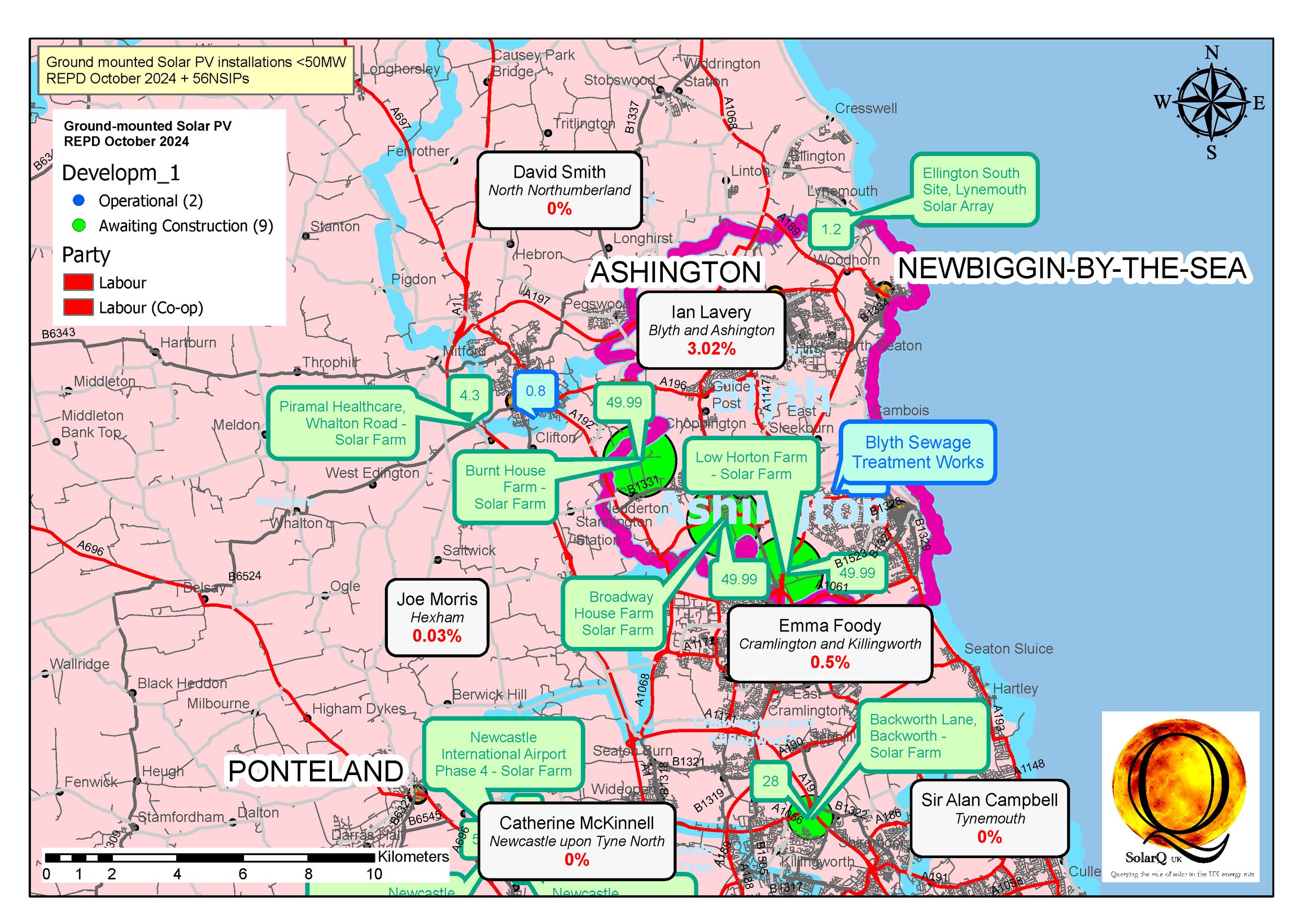Land-take by ground-mounted solar installations
The January 2024 Department for Energy Security and Net Zero’s Renewable Energy Planning Database (REPD) contains information on a total of 2,586 ground-mounted solar installations at various stages of planning, construction or operation. The total (nameplate) capacity of all installations is 37,740MW (37.7GW), of which 8,927MW (8.93GW) are currently operational.
Detailed maps were produced of the distribution of all the ground-mounted solar PV installations in the database, either at the level of Counties or Unitary authorities, or at the new Parliamentary constituencies’ level.
Lincolnshire has the greatest total solar PV figure (3,345MW), followed by Essex (2,194MWp) and Cambridgeshire (1,169MWp). Lincolnshire therefore also has the largest share, c.9%, of the UK’s total figure.
Using a figure for land-take per installed MWp based on current NSIP and other applications, the total area occupied by ground-mounted solar PV in each county was estimated. Solar land-take varies from zero to 1.19% in Nottinghamshire.
Of those Parliamentary constituencies with areas greater than 500 sq. kms, Gainsborough has the highest percentage cover with ground-mounted solar PV (2.81%), followed by Grantham & Bourne (2.12%) and North-West Essex (2.07%).
The analysis shows that the frequently quoted figure of solar PV occupying only 0.1% of the UK’s land area is wrong. Currently the correct figure is nearer 0.28% (assuming all viable proposals in the REPD database are carried to completion). The figure for England rises to 0.46%, well over four times the quoted figure.
Solar proposals often target agricultural land, which is 69% of the total land area of the UK. The total area occupied by (or already proposed for) solar farms in England amounts to the equivalent of 0.67% of its agricultural land. With a developing world food crisis, we can ill afford to lose more productive agricultural land to solar PV.
The Government’s stated aim to increase solar three-fold by 2030 (to 50GW) should be challenged in the light of these figures which under-estimate the present impact of solar on land-use because only 18 of 44 NSIPs currently under development are present in the REPD database used in this analysis.
The UK urgently requires a land-use strategy that takes into account the many conflicting demands placed upon the scarce resource of available land for agriculture, conservation, health and leisure activities, housing and renewable energy production. Click on the image (right) to read the full Report
Ground-mounted solar installations. The UK’s most affected constituencies, January 2025
The Renewable Energy Planning Database (REPD) does not include many of the large area, ground-mounted solar installations that have been or will be submitted under the NSIP regime. SolarQ has digitised the redline boundaries for the 56 NSIP proposals for which maps were available by January 2025 and added these to the October 2024 REPD information for ‘sub-NSIP’ installations (i.e. <50MW), so that we can now rank the new 2024 constituencies in terms of the total percentage of the area of each that is or will be affected by ground-mounted solar installations.
For the present iteration, information in the REPD on the area occupied by sub-NSIP installations (now given in the REPD) was used in a regression to calculate the average land-take per MWp installed capacity of these sub-NSIP schemes (the regression slope of 1.772 hectares/MWp is almost the same as the 1.793 hectares/MWp calculated from the NSIP installations in the Report in this section, which explains the approach in full). Areas of the NSIP installations were calculated directly from their digitised boundaries.
The maps below show the 20 most affected constituencies and the footnote for each, in red at the bottom, shows the rank, name and percentage of the total area that is, or will be, affected. Within each map, the icons for the different developmental stages of the REPD installations (see the map Legend) are scaled according to the MWp capacity of each (the largest icons usually represent installed capacities of 50MWp); the numbers in brackets after the icons and descriptions in the map Legend are the numbers of each type of installation within the map frame.
The background colours of the maps reflect those of the parties of the sitting MPs (see legend for full colour; map colours for each are faded) whose names, constituency names and percentage cover by solar installations are in the callouts within/near each constituency. The key constituency on each map is outlined in purple; other constituency boundaries are in pale blue (their MPs, names and percentage solar cover are also in callouts within/near each one).
Use the left/right arrows to see the maps.
(The maps below update information in the Report on this web-page, which is based on an earlier edition of the REPD and less complete information on the NSIP installations. The Report itself will be updated soon.)





















